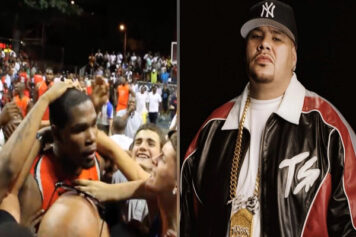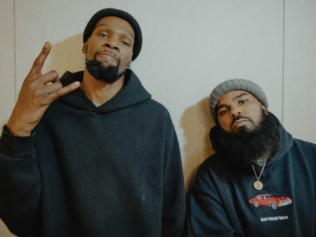This Friday, SHOWTIME premiere’s BASKETBALL COUNTY: In The Water, a documentary about Kevin Durant‘s Maryland hometown.
Viewed as a basketball hub for its many professional ballers that emerged from the region, this is Durant’s moment to showcase not only where he is from but more of who he is.
We spoke to Stephen Espinoza, President of Sports and Event Programming, Showtime Networks Inc., about the film chronicling the majority-black county that acts as the bedroom community of Washington, D.C.
“It was particularly interesting because obviously its near D.C., but its not a particularly urban environment. It is a mix of rural, urban and has a wide range of different demographics,” said Espinoza. “So the fact that it is a hot bed of talent merits investigation. I mean the big question is: where did this come from? When we were presented with the project that was what we sort of tasked Kevin, Rich and the filmmakers with.
“Let’s not just catalog all of the talent that comes from PG County, but let’s dig into how this happened, how did things develop. What are the societal and cultural factors that led to this phenomenon right now? To their credit, they dug in and they gave us answers.”
Welcome to PG County, where greatness lives.
Watch #BasketballCounty: In the Water Friday 9PM ET on @Showtime.@KDTrey5 @VicOladipo @QCook323 @MarissaC_25 @MarkelleF @richkleiman @35Ventures pic.twitter.com/oIlage5ZIJ
— SHOWTIME SPORTS (@SHOsports) May 13, 2020
Through archival footage that tells the narrative of the region, “Basketball County” In The Water” shows that this area and its prodigious basketball acumen has been hiding in plain sight.
“It’s not just as simple as, ‘hey, you know, sometimes these things go in waves and you have a generation of great talent that grows up together,’ said Espinoza. “There’s been several generations of talent and it’s clearly more than just luck and random chance and I think that’s the most interesting part of this doc. Digging in to who are the people that made it so, what are the societal and cultural factors though were not intended to result in basketball talent, inevitably did lead to what we see today.”
🔥🔥🔥 RT @SLAMonline: DeMatha. Dyckman. AAU. It didn’t matter cause Markelle Fultz was about his buckets. Catch “Basketball County: In the Water” on @SHOsports on May 15. #BasketballCounty pic.twitter.com/6xZtu573M1
— Bobby (@B_DUYILEINC) May 13, 2020
Durant, along with his manager/agent Rich Kleiman are the Executive Producers of the film. For Durant, who many feel can be truculent with the media, this is a bit of a coming-out-party for his origin story.
“So I think this is a way of Kevin beginning to share the private parts of his personality. It’s a window into part of his upbringing, part of the factors. I think, Kevin, maybe that’s a project that he’s got, holding it from the past. Maybe he’s still getting comfortable with the concept. But there is a fair amount of personal revelations here. He did set out to tell a larger story, not the Kevin Durant story, but the story of the environment that helped create Kevin Durant.”
However, the documentary is more about what factors in the County led to a proliferation of professional basketball stars. He enlists friends that also made it to the pro’s to round out the narrative.
Only two days until #BasketballCounty airs on Showtime at 9 PM EST!
Some local appearances include @TTOBasketball President/Coach Keith Stevens, @DeMathaHoops HC/alumnus Mike Jones, NBA standouts Adrian Dantley and @WaltTheWizard42, basketball Mr. Do-it-all @DCRick_, and more! https://t.co/92IgRgslb1
— DMVHoopHouse (@dmvhoophouse) May 13, 2020
“When you’re telling a story about Victor Oladipo and Quinn Cook and Michael Beaseley and Kevin Durant and Adrian Dantley, and you’re including those guys in the project itself, obviously every one of them is going to be committed to an accurate portrayal of what they went through.
“So this is as real and as authentic as it gets and Kevin made it clear from the very start, he was doing this project because he is very personally invested in the area. Not just in the timeframe in which he grew up, but like many other of the PG County stars, on from continuing to develop kids there who might become basketball stars. But more importantly are going to become productive members of society.”
SHOWTIME is not new to the athletic storytelling business. In fact, it is now a hallmark of their content offerings. From Allen Iverson to Kobe Bryant’s MUSE, SHOWTIME has been invested in athletes telling their own story through their voice for a long time.
“The Iverson project didn’t cover every single issue or every single event in A.I.’s life. But it was A.I. telling his story and his version of some very controversial and difficult events in his past in his own words. Going all the way back to Lawrence Taylor, his career in his words. Kobe’s career in his words. Ron Artest battled with mental health while he was playing in the NBA, in his own words. With that comes certain responsibilities and certain challenges.”
The documentary tackles community leaders and others who were influential in the lives of these players. Even when the story doesn’t have a neatly packaged ending, the film still shines the light on the realities behind the successes.
Aye young. I just saw there is a piece on PG County called #BasketballCounty coming out on Friday. Best believe imma watch that joint. #PGCounty pic.twitter.com/z1WTPNWJwJ
— James the Jedi Knight (@JayCRIII) May 13, 2020
“So when it came to, for example, the Curtis Malone story, and, Curtis is a figure that was very influential to a lot of the young men’s lives and young women as both a father figure and someone who was a huge supporter of youth basketball. But in order to tell the Curtis Malone’s story, you have to tell the whole story and it includes something which, you know, personally having not been familiar with the story was an unexpected twist at the end. I don’t want to spoil it for anybody who hasn’t seen it yet, but it was critical that I think we approach it objectively and completely, to tell the whole story.
“You know, this isn’t just the good part. This is everything that’s relevant. Everything that happened, everything which helps us understand the environment that we’re describing.”



